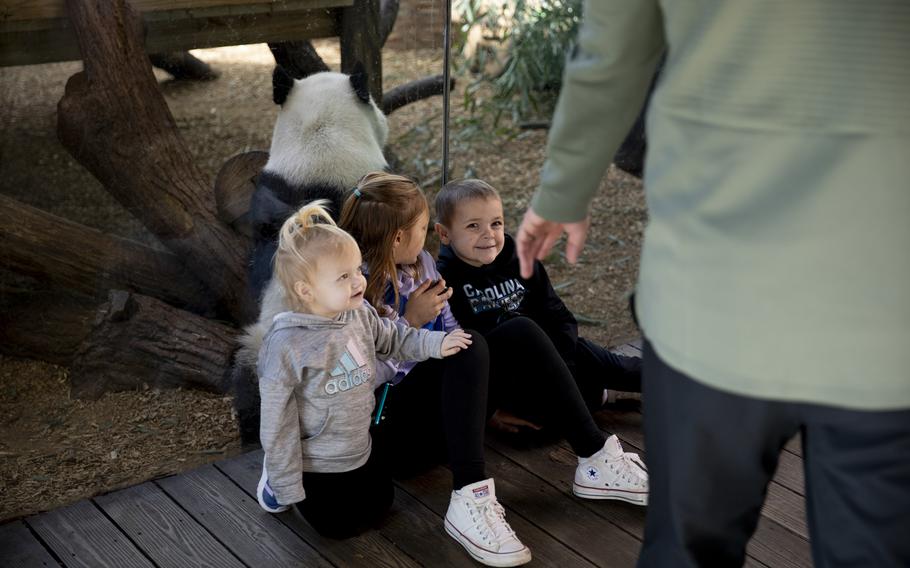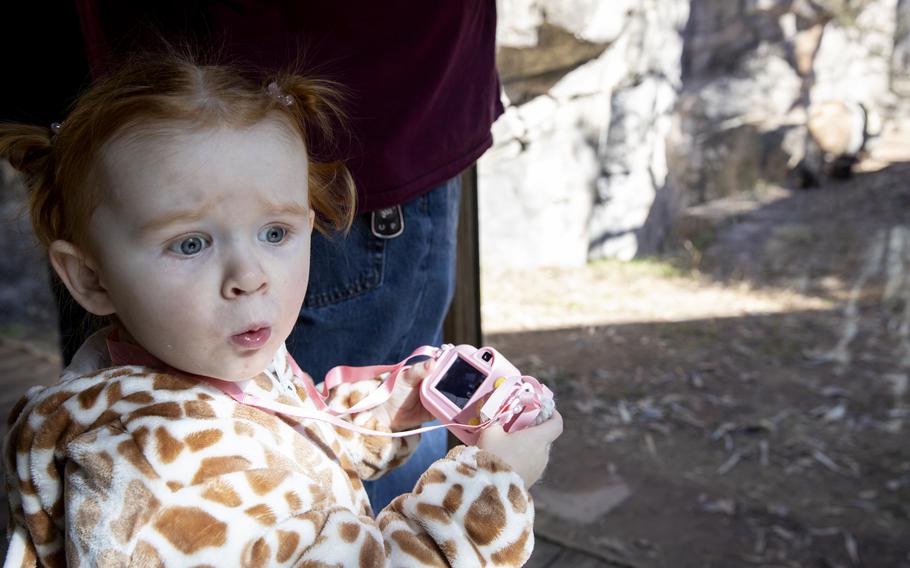
Jenny Owens, of Wilkesboro, N.C., watches the giant pandas at Zoo Atlanta. She’s been visiting the zoo to see the pandas for close to 10 years now. “I stay a week at a time and come every day,” she said. (Kendrick Brinson/For The Washington Post)
Mary Barker was determined to see the last remaining giant pandas in the United States, so she kept her foot on the gas. In December, she plowed through torrential rain while driving 18 hours each way from her home in northern Pennsylvania. In between she spent six hours at Zoo Atlanta, which is supposed to return the animals to China at an undetermined time this year.
“It was definitely worth it,” Barker said. “I would do it again in a heartbeat.”
While her adventure may have been a bit extreme, she is far from alone in her desire to visit the pandas while Americans can do so without a passport.
Travel agent Lainey Melnick, 61, flew from Austin to Atlanta for the Dec. 8 weekend “just to see the pandas.” She had previously seen them in D.C., and in Japan, but knew that visiting them in Atlanta would be her last opportunity for a while.
“I would even fly to China to see them, but it’s a lot easier to fly to Atlanta,” Melnick said.
Attendance at Zoo Atlanta has been higher than normal the past few months, and that’s “likely” due to the pandas, but other factors, like weather, may also be playing a role, said zoo spokeswoman Rachel Davis.
Anecdotally, there’s no doubt that panda FOMO is a motivator. On Facebook groups like the Ultimate Panda Fan, people have been sharing their travel plans and encouraging one another to make the trip. My trip came at my daughter’s suggestion. We made two outings to the zoo during a long weekend explicitly to see the pandas. We met Barker, 59, and her daughter, Helena, 30, on Dec. 11 after a zoo employee commented on how many out-of-towners had been visiting.

From left, Raimy Gray, 2, her sister Charlie, 9, and their brother Owen, 6, sit back-to-back with a giant panda as their parents Hope and Nathan take photos at Zoo Atlanta. The family traveled from Spartanburg, S.C. to see the bears. (Kendrick Brinson/For The Washington Post)
I announced that we’d flown in from Colorado. Another family had driven six hours from Kentucky. Barker outdid us all, sharing the story of her drive. She had been watching the “Today” show when she heard that the Smithsonian’s National Zoo in Washington, D.C., was returning its three giant pandas, and that the four in Atlanta were also due to leave.
“With so many things going on with China and the United States, I figured if they pulled the pandas out I would never get to see them,” she said.
A tax preparer, she knew her busy season was fast approaching and that she needed to act quickly if she was going to take the road trip. (For those who can’t make it to the Atlanta zoo, there are panda cams.)
“A storm was coming up the East Coast,” she recalled. “We didn’t care. It wasn’t keeping us away from the pandas.”
She drove alone from her home to Virginia Beach to pick up her daughter, then they continued to Atlanta. Nearly half the drive was in the pouring rain.
“We stayed overnight at a motel, got up and were at the zoo when it opened,” she said. In all, they spent about two hours watching the giant pandas, including listening to an educational talk by a zookeeper who let them touch a sample of panda fur. About four hours were spent exploring the rest of the zoo. Then they got back in their car and retraced their route.
Because there’s no set departure date yet, the Atlanta zoo is still “in the process of planning ways we will celebrate this very special legacy.” But if the Panda Palooza that the National Zoo held as a “cele-bear-ation” of its pandas is any indication, the number of arriving panda enthusiasts will go up.

Inside a gift shop at Zoo Atlanta. (Kendrick Brinson/For The Washington Post)
Visits to the National Zoo between Sept. 26 and Nov. 9 — roughly the start of Panda Palooza to the bears’ departure day — increased 179% over those of the same period in 2022, said Ellie Tahmaseb, a spokeswoman for the Smithsonian’s National Zoo and Conservation Biology Institute. More than 250,000 people entered the National Zoo over that six-week period last year, including guests from Alaska, Puerto Rico, Hawaii and Guam.
“Although I can’t say definitively this was due to the giant pandas, it’s hard to look at the data and come to any other conclusions,” she said.
The National Zoo had been nearly synonymous with pandas after housing them for more than 51 years. But, the first panda in the U.S. arrived in 1936 when it was brought over by socialite Ruth Harkness, then acquired by Chicago’s Brookfield zoo, where it died at 16 months old.
Panda diplomacy between the China and the United States began in 1972, when Hsing-Hsing and Ling-Ling were presented as gifts to commemorate President Richard M. Nixon’s historic trip to the communist country. The pair was exhibited at the National Zoo.
In the 1980s, China moved to “loan” pandas to zoos under 10-year contracts that not only rewarded friendly relations, but also brought in huge money to China’s conservation programs. The Atlanta zoo alone has contributed more than $16 million.
The deals were generally extended, but after President Donald Trump added tariffs to Chinese goods, a trade war ensued, and by 2019, the three bears at the San Diego zoo had been returned. The single bear in Memphis went back in April. The trio at the National Zoo was returned in early November.
Atlanta has had pandas for nearly a quarter-century, with Chinese-born Lun Lun and Yang Yang arriving in 1999, when they were both 2 years old. Their contract is set to expire in late 2024. Part of the agreement said that any offspring born in the zoo would be returned to China, so five of the pair’s seven cubs have already gone back. The two youngest, Ya Lun and Xi Lun, are now 7 years old and expected to travel to China this year as well.
The zoo anticipates getting “significant advance notice to share” before any actual return dates, Davis said. And, while there is some hope that panda diplomacy may live on, it is not clear if, when or where that might happen.
There’s no doubt the United States will miss its pandas, but it’s less clear that the pandas will miss the United States. Tahmaseb said during Xiao Qi Ji’s birthday party at the National Zoo this summer, the bear looked at the crowd singing to him and walked away, leaving his cake and his fans behind.
During my two days watching the pandas, there was a lot of sleeping, eating of bamboo and hanging out on a raised platform, interspersed with a bit of walking and some animated inspecting of the water fountain.

Valley Farnsworth, 2, watches and photographs the giant pandas at Zoo Atlanta. (Kendrick Brinson/For The Washington Post)
Helena Barker said the pandas were asleep when she and her mother first arrived. Still, she’s was “beyond thrilled” to see them in person.
“I couldn’t contain my excitement,” she said.